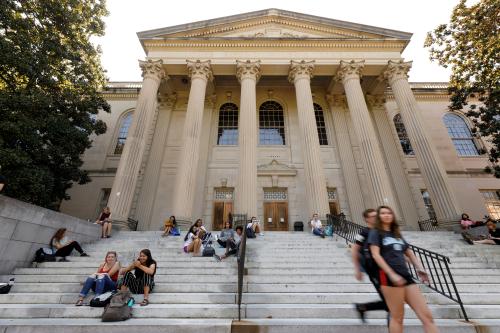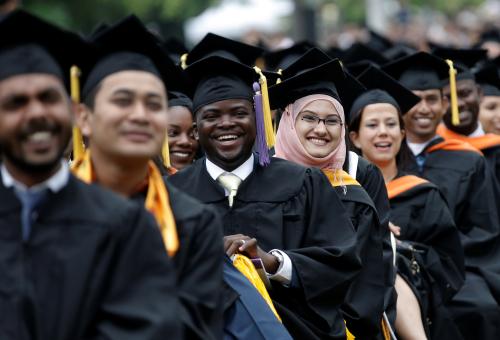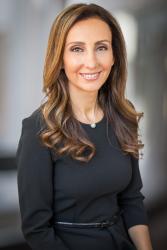This op-ed was adapted from a keynote address Maysa Jalbout delivered at the Bologna Process 2019 Higher Education Conference during the 20th anniversary of the Bologna Declaration. Participants included 45 ministries of education and over 200 universities from 80 countries.
Universities can turn one of our world’s most unconscionable injustices—unequal access to quality education—into one of the greatest hopes for our future.
Universities must address the education divide not only as a moral obligation but as an opportunity to tackle some of today’s biggest challenges.
They need to shift their mission from educating the few to educating all, leading the way in educating the most vulnerable people in their communities and around the world.
Most of the world is grappling with worsening and persistent challenges resulting from the slow or nonexistent progress for the most vulnerable disadvantaged people.
Income inequality remains at an all-time high.
Climate change threatens to destroy our planet, altering the course of humanity.
Income inequality, like conflict and climate change, affects the most vulnerable more disproportionately, everywhere.
And, recent reports project that it will take more than 108 years for women to achieve gender equality.
Education is both a remedy and at the root of inequality.
Data shows that education attainment is directly related to higher levels of income and equality.
For example, the World Bank estimates that every year of a women’s education increases her income by 10-20 percent. Yet, girls and women lag behind in access to education in many parts of the world, including in traditionally male-dominated fields such as STEM education in the developed world.
Low-income, rural, and first-generation students around the world are much less likely to enter and complete university. And, only 1 percent of refugees have access to higher education globally.
Strategies to deliver results
All children, youth, and adults deserve an education, and advances in technology can help make it possible.
Universities should be bold and consider two potential strategies that can deliver results at a large scale with greater impact.
First, universities should make higher education open for all who need it—regardless of status and financial ability.
Common inclusion programs, such as scholarships, are important and have had a marked impact on the lives of thousands of students around the world.
But, they cannot be the answer alone. The number of young people who deserve a quality higher education far outweighs what any one entity can offer. Even massive contributions to university endowment funds will only reach a select and lucky few students every year. For every student who receives a scholarship, there are thousands more who do not.
In the meantime, inequality in access to education continues to grow. Access to higher education has become one of the most divisive socio-economic barriers of recent times.
For this to change, universities must refocus their efforts from raising funds for a few select students to opening education to everyone who needs it. And, universities are beginning to make important steps.
In the United States, the University Innovation Alliance is comprised of universities as diverse as Georgia State to Purdue. The 11 universities came together with a common goal of innovating within their universities to significantly increase access to education among first generation students from 27 to 30 percent by 2022.
Advancements in technologies and online learning make it possible for all universities to open up.
One of the Alliance members—Arizona State University (ASU)—has ranked as the most innovative university in the U.S. by adopting metrics on how many students they take in rather than how many they keep out. One way they achieve this is by creating many pathways to entering and completing a degree, such as offering online freshman courses and accrediting online courses toward full degrees.
A recent example includes ASU’s collaboration with the Massachusetts Institute of Technology (MIT), where students who successfully complete MIT’s MicroMasters in Supply Chain Management can automatically receive credit and enroll in ASU’s Masters.
Innovative online solutions are encouraging and have the potential to be replicated by universities worldwide.
But technology is not a panacea. Education solutions that simply transfer courses offered face-to-face to online platforms still work for too few students to have a large impact.
Failed initiatives often have three strikes against them: They do not understand the needs of the populations they intend to serve; they are too expensive; and they underestimate the commitment required to make their efforts succeed.
By contrast, successful initiatives are designed around the needs of vulnerable populations.
For example, rather than offer courses in the main language of instruction (primarily English), universities with local partners understand that the most marginalized populations have limited English skills. Rather than offer courses online only, these universities build courses around support from local organizations that offer counseling and mentoring.
And, rather than end their commitment to students at graduation, these universities plan from the outset for how their offerings will help students transition to sustainable livelihoods.
In a nutshell, if universities want to educate the most vulnerable, they must redesign education to meet their needs.
Second, universities should give higher education a higher purpose—making learning possible for everyone at all levels of education.
Many universities perceive widening the education pipeline beyond university education well outside of their jurisdiction. After all, K-12 and adult education are led by other institutions and often regulated by other levels of government.
But, if universities want to help make education radically more accessible, they will reconsider whom they see as their students.
To be truly inclusive of vulnerable populations, universities must partner with schools to ensure that students are prepared for college success.
Early counseling and mentoring programs can alter students’ trajectory by helping them make good choices and develop the skills needed to succeed in university and beyond.
At the adult education level, universities are well positioned to offer up-skilling courses such as massive open online courses (MOOCs). Early impact studies of MOOCs show that short online courses and credentials have had the largest uptake among educated adults already in the workplace. They enroll in popular courses like coding and data analytics as a way to get ahead in their careers or in anticipation of career changes. But MOOCs need to be rethought if they are to be more relevant to those who have not had access to education or are unemployed.
Beyond reaching adult learners, MOOCs express an important sentiment: Making education more accessible does not have to be limited to transition to and from university but rather reach learners at every stage.
Universities can help develop new education solutions. By increasing investment in education, research, and innovation to similar levels as other areas such as health, universities could develop solutions to some of the most persistent education challenges.
It was not long ago that the progress universities made in stem cell research and 3D printing of organs would have been unimaginable. Why then would it be inconceivable to imagine that universities could play a leading role in closing the 100-year education gap for millions of children in developing countries?
As institutions that have helped alter the course of society for the better so often in the past, we need universities to lead the way in changing the current course of education.
It is time to expand the mission of universities from educating the few to educating everyone, including those who are most vulnerable.
Every child, every refugee, every migrant, and every woman deserves equal access to an education that sets them up for success. And, universities can make it possible, if they truly harness their power for the purpose of educating vulnerable people.







Commentary
Op-edEducating the most vulnerable: Universities’ greatest impact
July 17, 2019